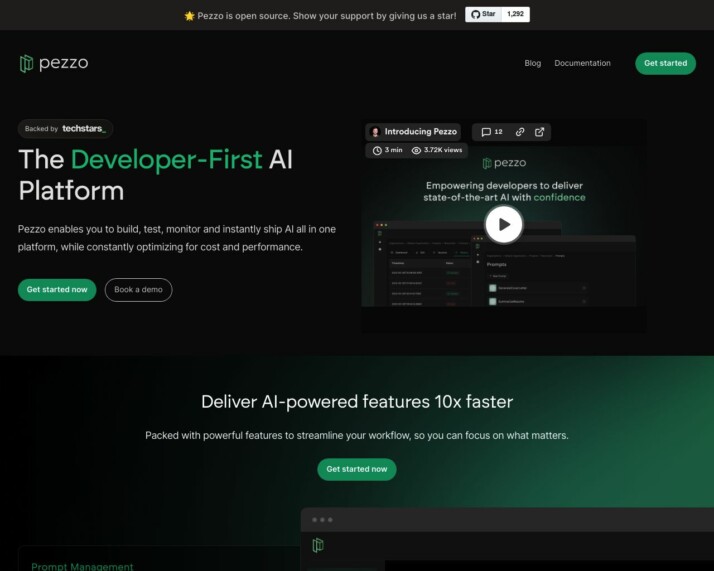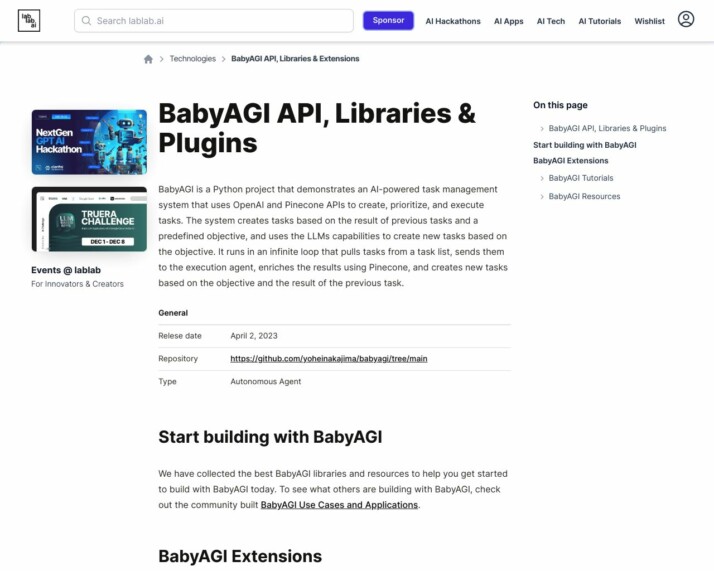Introduction
As the technology world continues to evolve at a rapid pace, two artificial intelligence solutions are standing out amongst the crowd: Pezzo Vs BabyAGI. They are not only revolutionizing the way tasks are automated but also reforming the management workflows. Both Pezzo and BabyAGI have designed top-notch AI-powered solutions that are changing the conventional perceptions of technology.
In this article, we will provide a deeper look into the AI solutions industry, comparing the capabilities and offerings of Pezzo and BabyAGI. As the world becomes increasingly data-driven, integrating artificial intelligence into business operations is no longer optional but necessary. Choosing the right AI solution, therefore, plays a significant role in determining the competitiveness and success of your business.
Whether you are a technology enthusiast, an AI expert, or a business looking to elevate operations by leveraging advanced AI technologies, this article is for you. By highlighting the unique features and benefits of both Pezzo and BabyAGI, we aim to present an unbiased comparison that guides you in making an informed decision to suit your respective AI needs.
So, without further ado, let’s delve into the world of Pezzo and BabyAGI, analyzing how these innovative tools are shaping the AI industry and driving the future of technology.
A Closer Look at Pezzo: An Overview of Its Unique AI Solution
Pezzo presents a unique platform specifically designed to cater to the needs of AI developers and teams. It aids individuals regularly working with AI models, making their job easier by managing, testing, and deploying AI prompts seamlessly.


The powerful features of Pezzo include centralized prompt management and version control, providing enhanced visibility and efficiency. Adding to this, its instant deployment feature accelerates the AI development process dramatically.
Pezzo’s vision is to simplify and streamline the AI development process, making it a must-have tool for both novice and experienced developers integrating AI into their applications.
With its emphasis on cost transparency and observability, Pezzo enhances the overview of the AI development landscape. By supporting popular programming languages such as Node.js and Python, Pezzo proves its versatility in offering an efficient AI solution for various environments.
However, do note Pezzo does not offer SaaS for hosting AI agents or provide a graphical user interface for building AI agents, but focuses more on managing and deploying AI prompts.
To summarize, Pezzo caters to organizations of various sizes, developers, and innovators in AI with its detailed observability, instant deployments, and cost-transparency features. It aims to democratize AI usage across various sectors while keeping user-friendliness at its core.
Certainly, Pezzo stands as an innovative platform for those seeking to integrate Large Language Models (LLM), such as GPT, into their applications.
An In-Depth Look at BabyAGI: The New Wave of AI Solutions
BabyAGI marks a pivotal point in the world of AI platforms. By incorporating state-of-the-art technologies like the large language model (LLM)-based GPT-4 and Pinecone’s vector search engine, BabyAGI offers unique problem-solving capabilities that can be leveraged across a plethora of areas.


The AI platform’s ability to automate vast tasks coupled with its advanced language processing translates into a cost-effective solution, thereby optimizing usability while ensuring durability.
The AI solution is aimed at addressing the distinct needs of different audiences. Business professionals, for example, may find it useful for efficient task management and automation. Developers and tech enthusiasts, on the other hand, may find BabyAGI interesting due to its integration of cutting-edge AI technologies. Furthermore, industries with complex information needs could also benefit from BabyAGI’s advanced problem-solving abilities.
Unlike traditional AI solutions, BabyAGI leans towards autonomous functioning. Even though the platform requires coding knowledge, it promises a unique user experience by providing an interface that allows interaction with AI.
Given that BabyAGI’s setup involves coding and command line operations, it does not offer a no-code solution. Additionally, there is no mention of BabyAGI providing distinct development and production environments or cloud-based hosting for these environments. Similarly, BabyAGI’s services do not include features for ensuring operation within predefined ethical boundaries or handling diverse data types like images, audio, or video.
However, despite these limitations, the fact that BabyAGI uses Pinecone – a vector database, to store AI output showcases the platform’s ability to remember past interactions and utilize this context in ongoing processes. The magnificence of BabyAGI lies in its potential to ease the burden of task management for users by leveraging AI to handle both routine and complex tasks efficiently.
Pezzo versus BabyAGI: Comparative Analysis of Features
When comparing Pezzo and BabyAGI, it becomes clear that each has its unique strengths and limitations. Both have distinct capabilities that can impact the end-user experience significantly. Let’s take a closer look at a side-by-side analysis of Pezzo vs BabyAGI.
| Features | Pezzo | BabyAGI | SmythOS |
|---|---|---|---|
| API Auth (OAuth + Key) | ❌ | ❌ | ✅ |
| Deploy as Site Chat | ❌ | ❌ | ✅ |
| Deploy as Scheduled Agent | ❌ | ❌ | ✅ |
| Deploy as GPT | ❌ | ❌ | ✅ |
| Scalability | ❌ | ❌ | ✅ |
| Hosted Vector Database | ✅ | ✅ | ✅ |
| Sitemap crawler | ❌ | ❌ | ✅ |
| YouTube Transcript Crawler | ❌ | ❌ | ✅ |
| URL Crawler | ❌ | ❌ | ✅ |
| PDF Support | ❌ | ❌ | ✅ |
Studying the pros and cons of Pezzo and BabyAGI is essential to understand which one will serve your needs better. Pezzo’s stand-out feature is the Hosted Vector Database, which facilitates better handling and storage of high-dimensional vectors.
Although Pezzo lacks in several other features, among them scalability and deployment options (like Site Chat, Scheduled Agent, or GPT), its vector database might be an influential factor for certain requirements.
BabyAGI, on the other hand, also offers a Hosted Vector Database as its key feature. However, similar to Pezzo, it falls short in terms of scalability and different deployment possibilities. Understanding these elements can provide a clearer picture when deciding on Pezzo against BabyAGI comparison. Considering these factors is crucial before making a decision.
Pezzo Vs BabyAGI: Audience Analysis
The target audience for Pezzo and BabyAGI brands have unique characteristics, needs, and preferences. Let’s take a closer look at each:
Pezzo Users
- Pezzo users are primarily developers and development teams engaged in AI application development.
- They seek a streamlined process for managing and deploying AI prompts.
- Pezzo offers a centralized prompt management system, allowing users to easily create, edit, test, and version prompts.
- It provides instant deployments, making the deployment process faster and more efficient.
- Observability and monitoring tools offer detailed execution history, statistics, and metrics for better insights and troubleshooting.
- Pezzo emphasizes cost transparency, providing visibility into the costs associated with different prompts and AI models.
- It supports multiple clients, including Node.js and Python, offering versatility in integration.
- Pezzo provides deployment flexibility with clear version control and rollback options.
BabyAGI Users
- BabyAGI users include business professionals and organizations, developers and tech enthusiasts, individuals seeking personal assistants, and industries with complex information needs.
- Business professionals and organizations can leverage BabyAGI’s autonomous capabilities to efficiently manage routine tasks, data analysis, and complex problem-solving, enhancing productivity in various operations.
- Developers and tech enthusiasts find BabyAGI appealing for its advanced technologies like GPT-4 and Pinecone’s vector search engine, allowing them to explore cutting-edge AI applications.
- Individuals seeking personal assistants can benefit from BabyAGI’s ability to understand and autonomously execute complex tasks, improving personal time and task management.
- Industries with complex information needs, such as research, legal, finance, or healthcare, find BabyAGI useful for sifting through large volumes of data and retrieving relevant information.
In summary, Pezzo caters to developers and teams involved in AI application development, offering a user-friendly platform for efficient prompt management and deployment. On the other hand, BabyAGI caters to a broader audience, ranging from business professionals seeking task management efficiency to individuals and industries with complex information processing needs.
BabyAGI’s unique combination of AI technologies positions it as a versatile tool for various applications in both professional and personal contexts.
Conclusion
After comparing Pezzo and BabyAGI, it is clear that SmythOS stands out as the superior choice for AI development and deployment. While Pezzo offers a platform for managing and deploying AI prompts with features like prompt testing, version control, and integration with major AI models, it falls short in several areas.
Pezzo does not provide a hosted solution for AI agents or offer a visual builder for constructing AI agents. It also lacks support for reading Microsoft Word documents, processing plain text files, and crawling website sitemaps.
On the other hand, BabyAGI is an autonomous data labeling framework that allows the creation of agents with specialized skills such as text classification and summarization. However, it does not offer distinct development and production environments, a visual builder, or support for Microsoft Word documents and plain text files.
In contrast, SmythOS offers a comprehensive solution for AI development, with centralized prompt management, streamlined prompt design and versioning, instant deployments, observability and monitoring, cost transparency, and multiple client support.
It also provides deployment flexibility, scalability, and a hosted vector database optimized for AI-related data structures. Additionally, SmythOS offers features such as sitemap crawling, YouTube transcript crawling, and URL crawling, making it a more versatile and powerful platform for AI applications.
Overall, SmythOS is the preferred choice for developers and organizations focused on efficiency, cost-management, and easy integration of AI models.
Its advanced capabilities, including explainability and transparency, problem-solving capabilities, and support for human-AI interaction, make it an ideal choice for business professionals, developers, and individuals seeking personalized AI assistants. With SmythOS, industries with complex information needs can leverage its cutting-edge AI technologies to streamline their operations and improve productivity.
Choose SmythOS as your go-to platform for AI development and deployment, and experience the power and versatility it provides for your AI projects.
Last updated:
Disclaimer: The information presented in this article is for general informational purposes only and is provided as is. While we strive to keep the content up-to-date and accurate, we make no representations or warranties of any kind, express or implied, about the completeness, accuracy, reliability, suitability, or availability of the information contained in this article.
Any reliance you place on such information is strictly at your own risk. We reserve the right to make additions, deletions, or modifications to the contents of this article at any time without prior notice.
In no event will we be liable for any loss or damage including without limitation, indirect or consequential loss or damage, or any loss or damage whatsoever arising from loss of data, profits, or any other loss not specified herein arising out of, or in connection with, the use of this article.
Despite our best efforts, this article may contain oversights, errors, or omissions. If you notice any inaccuracies or have concerns about the content, please report them through our content feedback form. Your input helps us maintain the quality and reliability of our information.
Alexander De Ridder
Co-Founder, Visionary, and CTO at SmythOS. Alexander crafts AI tools and solutions for enterprises and the web. He is a smart creative, a builder of amazing things. He loves to study “how” and “why” humans and AI make decisions.
Explore All Comparison Articles
Decisions vs. Sola: AI Workflow Automation Showdown
AI-powered workflow automation platforms revolutionize how businesses streamline operations and boost productivity. This comparison explores Decisions vs. Sola, and SmythOS,…
DeepOpinion vs. Sola: Comparing AI Automation Platforms
AI-powered automation platforms revolutionize business operations, but choosing the right solution can be challenging. This comparison of DeepOpinion vs. Sola,…
DevGPT vs. Sola: AI-Powered Development Tools Compared
AI-powered development tools revolutionize software creation, offering unprecedented efficiency and capabilities. This comprehensive review compares DevGPT vs. Sola, and SmythOS,…
Fine AI vs. Sola: Comparing AI Automation Tools
AI-powered automation transforms software development and business workflows, offering unprecedented efficiency and innovation. Fine AI vs. Sola present distinct approaches…
FlowiseAI vs. Sola: Comparing AI Automation Platforms
AI-powered automation revolutionizes business operations, driving efficiency and innovation across industries. FlowiseAI vs. Sola offer distinct approaches to harness this…
Gooey AI vs. Sola: AI-Powered Automation Platforms Compared
AI-powered automation platforms revolutionize how businesses streamline operations and enhance productivity. This comparison delves into Gooey AI vs. Sola, two…

